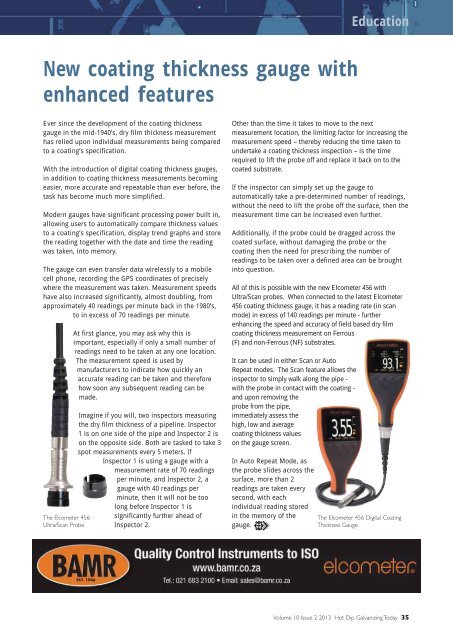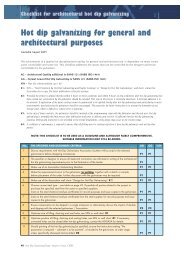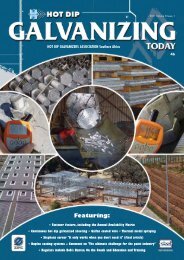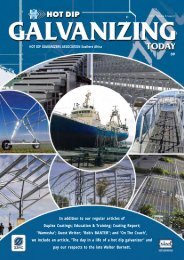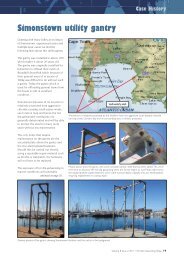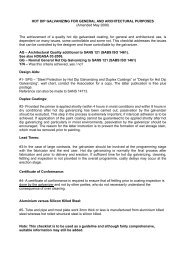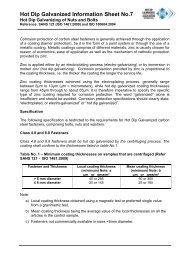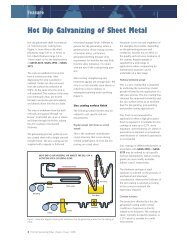Fasteners - hdgasa
Fasteners - hdgasa
Fasteners - hdgasa
You also want an ePaper? Increase the reach of your titles
YUMPU automatically turns print PDFs into web optimized ePapers that Google loves.
Education<br />
New coating thickness gauge with<br />
enhanced features<br />
Ever since the development of the coating thickness<br />
gauge in the mid-1940’s, dry film thickness measurement<br />
has relied upon individual measurements being compared<br />
to a coating’s specification.<br />
With the introduction of digital coating thickness gauges,<br />
in addition to coating thickness measurements becoming<br />
easier, more accurate and repeatable than ever before, the<br />
task has become much more simplified.<br />
Modern gauges have significant processing power built in,<br />
allowing users to automatically compare thickness values<br />
to a coating’s specification, display trend graphs and store<br />
the reading together with the date and time the reading<br />
was taken, into memory.<br />
The gauge can even transfer data wirelessly to a mobile<br />
cell phone, recording the GPS coordinates of precisely<br />
where the measurement was taken. Measurement speeds<br />
have also increased significantly, almost doubling, from<br />
approximately 40 readings per minute back in the 1980’s,<br />
to in excess of 70 readings per minute.<br />
The Elcometer 456<br />
Ultra/Scan Probe.<br />
At first glance, you may ask why this is<br />
important, especially if only a small number of<br />
readings need to be taken at any one location.<br />
The measurement speed is used by<br />
manufacturers to indicate how quickly an<br />
accurate reading can be taken and therefore<br />
how soon any subsequent reading can be<br />
made.<br />
Imagine if you will, two inspectors measuring<br />
the dry film thickness of a pipeline. Inspector<br />
1 is on one side of the pipe and Inspector 2 is<br />
on the opposite side. Both are tasked to take 3<br />
spot measurements every 5 meters. If<br />
Inspector 1 is using a gauge with a<br />
measurement rate of 70 readings<br />
per minute, and Inspector 2, a<br />
gauge with 40 readings per<br />
minute, then it will not be too<br />
long before Inspector 1 is<br />
significantly further ahead of<br />
Inspector 2.<br />
Other than the time it takes to move to the next<br />
measurement location, the limiting factor for increasing the<br />
measurement speed – thereby reducing the time taken to<br />
undertake a coating thickness inspection – is the time<br />
required to lift the probe off and replace it back on to the<br />
coated substrate.<br />
If the inspector can simply set up the gauge to<br />
automatically take a pre-determined number of readings,<br />
without the need to lift the probe off the surface, then the<br />
measurement time can be increased even further.<br />
Additionally, if the probe could be dragged across the<br />
coated surface, without damaging the probe or the<br />
coating then the need for prescribing the number of<br />
readings to be taken over a defined area can be brought<br />
into question.<br />
All of this is possible with the new Elcometer 456 with<br />
Ultra/Scan probes. When connected to the latest Elcometer<br />
456 coating thickness gauge, it has a reading rate (in scan<br />
mode) in excess of 140 readings per minute - further<br />
enhancing the speed and accuracy of field based dry film<br />
coating thickness measurement on Ferrous<br />
(F) and non-Ferrous (NF) substrates.<br />
It can be used in either Scan or Auto<br />
Repeat modes. The Scan feature allows the<br />
inspector to simply walk along the pipe -<br />
with the probe in contact with the coating -<br />
and upon removing the<br />
probe from the pipe,<br />
immediately assess the<br />
high, low and average<br />
coating thickness values<br />
on the gauge screen.<br />
In Auto Repeat Mode, as<br />
the probe slides across the<br />
surface, more than 2<br />
readings are taken every<br />
second, with each<br />
individual reading stored<br />
in the memory of the<br />
gauge.<br />
The Elcometer 456 Digital Coating<br />
Thickness Gauge.<br />
Volume 10 Issue 2 2013 Hot Dip Galvanizing Today 35


